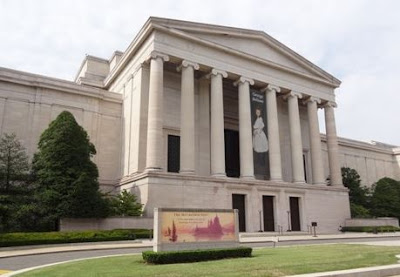The National Gallery of art Washington, DC is an art museum that features work from as early as the 13th Century up until the present. The Gallery grew so expansive at one point (with currently over 100,000 objects), that the collection had to be spread across two buildings. Since 1978 all work that pre-dates the 20th Century has been located within the West Building, while the East Building contains more modern art. Amongst the best known artists whose work is featured within the National Gallery of Art includes Degas, Monet, Renoir and Van Gogh. In addition, the only work by Leonardo DA Vinci physically located within the United States is located here. This work, titled Generva de’ Benci, depicts the famous 15th century aristocrat from Florence, Italy and was painted by DA Vinci around 1474.
 |
| National Gallery of art Washington |
The museum was formally dedicated by President Franklin Delano Roosevelt on March 17, 1941. At its opening the museum consisted of 130 galleries, of which only five actually contained works of art.
The building was constructed in a Neoclassical style of Tennessee marble and in the designs of John Russell Pope (best known for his work on the Jefferson Memorial, and who also would not sadly live to see the building’s opening). At the time it was built the National Gallery consisted of the most marbles ever used within the construction of a single building. In fact, the amount of marble required was deemed so substantial that there was an insufficient amount of single-tone marble and thus multiple tones may be seen throughout the facade. The most noted features of the building are its eight Ionic columns which grace the front entrance along with its central domed rotunda.
For construction of the neighboring East Building in 1978, the original marble quarries used in the West Building were re-opened. The building from street-view appears as a large letter H but is actually shaped as a triangle. It was designed by architect I.M. Pei (best known for his pyramidal additions to the Louvre Museum in Paris) who was forced to create a similar triangular design based upon the allotted land for the project. The East Building was officially dedicated on June 1, 1978 by President Jimmy Carter.
Another addition to the museum was added just one year later, although this was a part of the building’s exterior. On May 23, 1999 a 6.1 acre sculpture garden was unveiled after having been planned for more than thirty years. Included within this garden (outside of the obvious statues) are a fountain and reflecting pool near the center. During the winter months, this pool is transformed into an ice skating rink for the public to enjoy. The Sculpture Garden’s hours vary slightly based upon time of the year, but typically align with the hours of the Museum itself, which is open Monday through Saturday 10 am 5 pm and Sunday 11 am 6 pm.
The National Gallery of art Washington, DC is open 363 days of the year (closed only on Christmas Day and New Years Day) and offers various tour options. Information on all available tours is available at the Art Information Desk near the front entrance, or you may also preview tour dates/times online at www.nga.gov. It is recommended that if you desire a guided tour that you plan in advance as times of tours do vary. Some sample guided tour options include the Introduction to the West Building Collection or a similar offering of the East Building Collection. Each of these tours is free. For self-guided tour options, visitors may listen to the Acoustiguide Audio Tour, which is also free and even includes a children’s version.
Prior to the construction of the National Gallery of art Washington, DC, this was the site of the Sixth Street rail station along the Baltimore & the Potomac (B&P) Railroad. It was at this station that the assassination of President James Garfield would occur on July 2, 1881.
- Website: http://www.nga.gov/
- Address: Intersection of 4th Street, NW and Constitution Avenue, NW, Washington, DC
- Cost: Free
